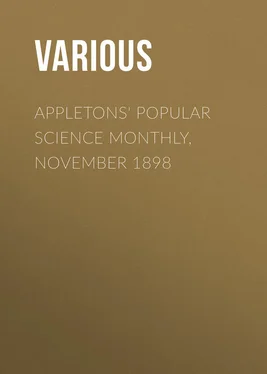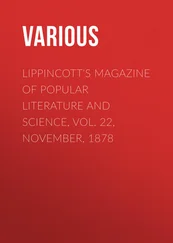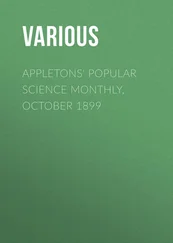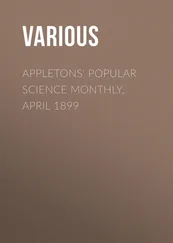Various - Appletons' Popular Science Monthly, November 1898
Здесь есть возможность читать онлайн «Various - Appletons' Popular Science Monthly, November 1898» — ознакомительный отрывок электронной книги совершенно бесплатно, а после прочтения отрывка купить полную версию. В некоторых случаях можно слушать аудио, скачать через торрент в формате fb2 и присутствует краткое содержание. Издательство: Иностранный паблик, Жанр: periodic, foreign_edu, на английском языке. Описание произведения, (предисловие) а так же отзывы посетителей доступны на портале библиотеки ЛибКат.
- Название:Appletons' Popular Science Monthly, November 1898
- Автор:
- Издательство:Иностранный паблик
- Жанр:
- Год:неизвестен
- ISBN:нет данных
- Рейтинг книги:5 / 5. Голосов: 1
-
Избранное:Добавить в избранное
- Отзывы:
-
Ваша оценка:
- 100
- 1
- 2
- 3
- 4
- 5
Appletons' Popular Science Monthly, November 1898: краткое содержание, описание и аннотация
Предлагаем к чтению аннотацию, описание, краткое содержание или предисловие (зависит от того, что написал сам автор книги «Appletons' Popular Science Monthly, November 1898»). Если вы не нашли необходимую информацию о книге — напишите в комментариях, мы постараемся отыскать её.
Appletons' Popular Science Monthly, November 1898 — читать онлайн ознакомительный отрывок
Ниже представлен текст книги, разбитый по страницам. Система сохранения места последней прочитанной страницы, позволяет с удобством читать онлайн бесплатно книгу «Appletons' Popular Science Monthly, November 1898», без необходимости каждый раз заново искать на чём Вы остановились. Поставьте закладку, и сможете в любой момент перейти на страницу, на которой закончили чтение.
Интервал:
Закладка:
The limit of practical work in the direction of new textile industries is so clearly defined that the expert need never be in doubt regarding the economic value of any fiber plant that may be submitted to him for an opinion, and the long catalogue of mere fibrous substances will never demand his serious attention.
In studying the problem of the establishment of new fiber industries, therefore, we should consider "materials" rather than particular species of plants – utility or adaptation rather than acclimatization. We should study the entire range of textile manufacture, and before giving attention to questions of cultivation we should first ascertain how far the plants which we already know can be produced within our own borders may be depended upon to supply the "material" adapted to present demands in manufacture. If the larger part of our better fabrics – cordage and fine twines, bagging, and similar rough goods – can be made from cotton, flax, common hemp, and Sisal hemp, which we ought to be able to produce in quantity at home, there is no further need of costly experiments with other fibers. Unfortunately, however, it is possible for manufacturers to "discriminate" against a particular fiber when the use of another fiber better subserves their private interests. As an example, common hemp was discriminated against in a certain form of small cordage, in extensive use, because by employing other, imported fibers, it has been possible in the past to control the supply, and in this day of trusts such control is an important factor in regulating the profits. With common hemp grown on a thousand American farms in 1890, the price of Sisal and Manila hemp binding twine, of which fifty thousand tons were used, would never have been forced up to sixteen and twenty cents a pound, when common hemp, which is just as good for the purpose, could have been produced in unlimited quantity for three and a half cents. The bagging with which the cotton crop is baled is made of imported jute, but common hemp or even low-grade flax would make better bagging. A change from jute to hemp or flax in the manufacture of bagging (it would only be a return to these fibers), could it be brought about, would mean an advantage of at least three million dollars to our farmers. Yet in considering such a desirable change we are confronted with two questions: Is it possible to compete with foreign jute? and can prejudice be overcome? For it is true that there are, even among farmers, those who would hesitate to buy hemp bagging at the same price as jute bagging because it was not the thing they were familiar with. But some of them will buy inferior jute twine, colored to resemble hemp, at the price of hemp, and never question the fraud.
Cabbage Palmetto in Florida.
Our farmers waste the fibrous straw produced on the million acres of flax grown for seed. It has little value, it is true, for the production of good spinning flax, yet by modifying present methods of culture, salable fiber can be produced and the seed saved as well, giving two paying crops from the same harvest where now the flaxseed grower secures but one.
In summarizing the situation in this country, therefore, it will be seen that, out of the hundreds of fibrous plants known to the botanist and to the fiber expert, the textile economist need only consider four or five species and their varieties, all of them supplying well-known commercial products that are regularly quoted in the world's market price current, the cultivation and preparation of which are known quantities. Were the future of new fiber industries in this country to rest upon this simple statement, there would be little need of further effort. The problem, however, is one of economical adaptation to conditions not widely understood in the first place, and not altogether within control in the second.
Twenty flax farmers in a community decide to grow flax for fiber, and two of these farmers are perhaps acquainted with the culture. They go to work each in his own way; ten make a positive failure in cultivation for lack of proper direction, five of the remaining ten fail in retting the straw, and five succeed in turning out as many different grades of flax line, only one grade of which may come up to the standard required by the spinners. And all of them will have lost money. If the failure is investigated it will be discovered that the proper seed was not used; in some instances the soil was not adapted to the culture, and old-fashioned ideas prevailed in the practice followed. The straw was not pulled at the proper time, and it was improperly retted. The breaking and scutching were accomplished in a primitive way, because the farmers could not afford to purchase the necessary machinery, and of course they all lost money, and decided in future to let flax alone.
But the next year the president of the local bank, the secretary of the town board of trade, and three or four prosperous merchants formed a little company and built a flax mill. A competent superintendent – perhaps an old country flax-man – was employed, a quantity of good seed was imported, and the company contracted with these twenty farmers to grow five, ten, or fifteen acres of flax straw each, under the direction of the old Scotch superintendent. The seed was sold to them to be paid for in product; they were advised regarding proper soil and the best practice to follow; they grew good straw, and when it was ready to harvest the company took it off their hands at a stipulated price per ton. The superintendent of the mill assumed all further responsibility, attended to the retting, and worked up the product. Result: several carloads of salable flax fiber shipped to the Eastern market in the winter, the twenty farmers had "money to burn" instead of flax straw, and the company was able to declare a dividend. This is not altogether a supposititious case, and it illustrates the point that in this day of specialties the fiber industry can only be established by co-operation.
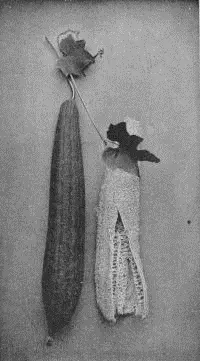
The Luffa, or Sponge Cucumber.
In all these industries, whether the fiber cultivated is flax, ramie, or jute, the machine question enters so largely into the problem of their successful establishment that the business must be conducted on a large scale. Even in the growth of Sisal hemp in Florida, should it be attempted, the enterprise will only pay when the necessary mill plant for extracting the fiber is able to draw upon a cultivated area of five hundred acres. In other words, the small farmer can never become a fiber producer independently, but must represent a single wheel in the combination.
The subject is a vast one, and, while I have been able to set forth the importance of these industries as new sources of national prosperity, only an outline has been given of the difficulties which are factors in the industrial problem. Summing up the points of vantage, the market is already assured; through years of study and experiment we are beginning to better understand the particular conditions that influence success or failure in this country; we have the best agricultural implements in the world, and American inventive genius will be able, doubtless, in time, to perfect the new mechanical devices which are so essential to economical production; our farmers are intelligent and industrious, and need only the promise of a fair return for their labor to enter heart and soul into this work.
WHAT IS SOCIAL EVOLUTION?
Though to Mr. Mallock the matter will doubtless seem otherwise, to most it will seem that he is not prudent in returning to the question he has raised; since the result must be to show again how unwarranted is the interpretation he has given of my views. Let me dispose of the personal question before passing to the impersonal one.
Читать дальшеИнтервал:
Закладка:
Похожие книги на «Appletons' Popular Science Monthly, November 1898»
Представляем Вашему вниманию похожие книги на «Appletons' Popular Science Monthly, November 1898» списком для выбора. Мы отобрали схожую по названию и смыслу литературу в надежде предоставить читателям больше вариантов отыскать новые, интересные, ещё непрочитанные произведения.
Обсуждение, отзывы о книге «Appletons' Popular Science Monthly, November 1898» и просто собственные мнения читателей. Оставьте ваши комментарии, напишите, что Вы думаете о произведении, его смысле или главных героях. Укажите что конкретно понравилось, а что нет, и почему Вы так считаете.
